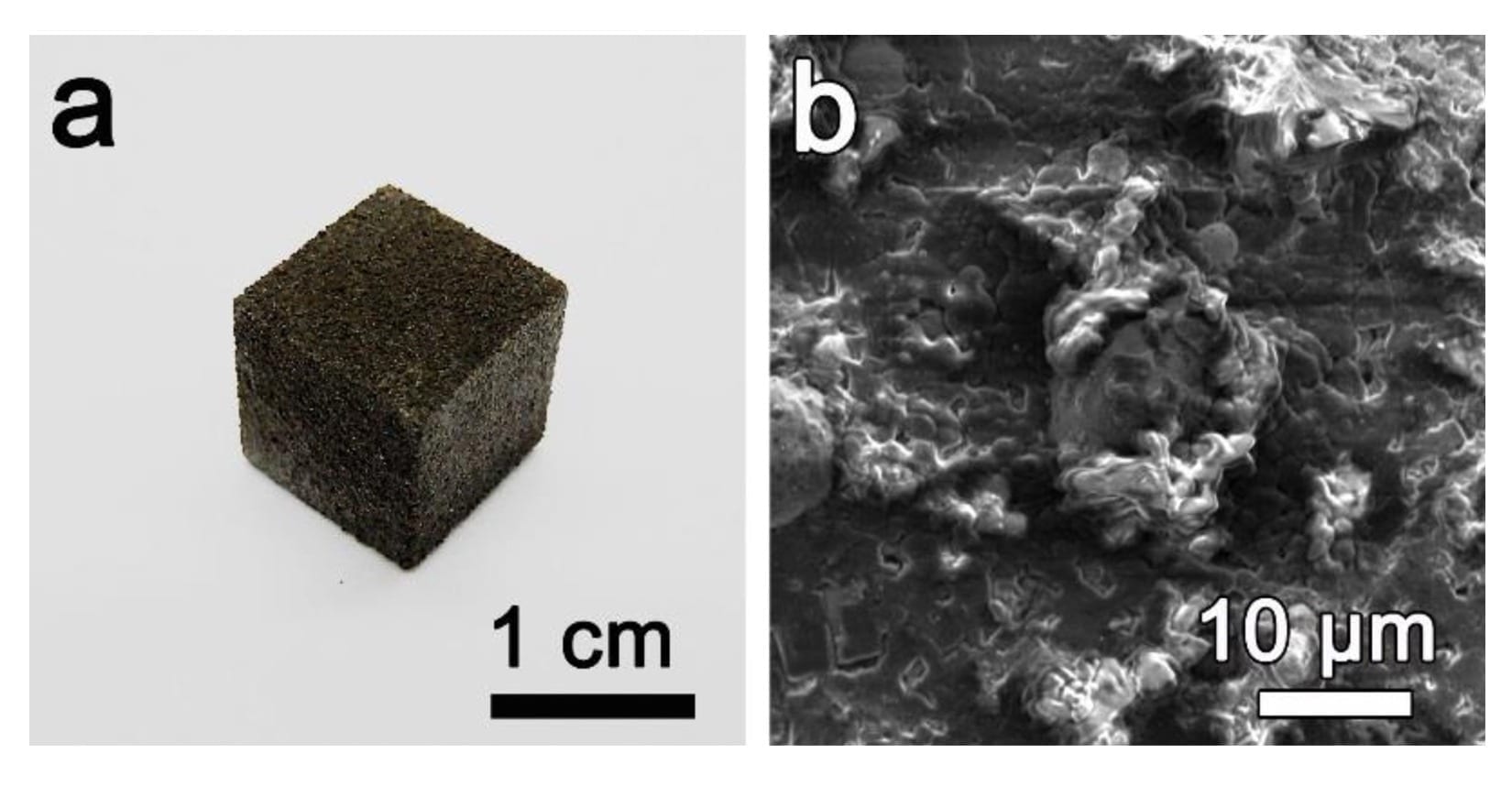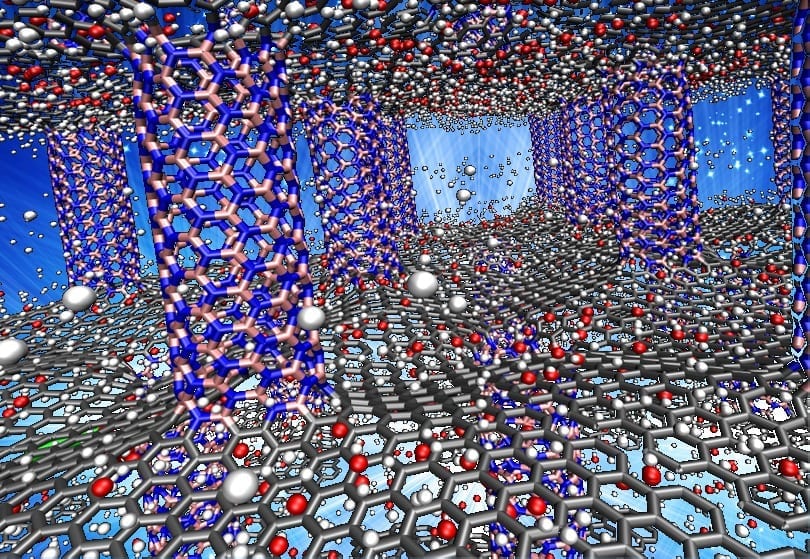
Nanotechnologists from Rice University and China’s Tianjin University have used 3-D laser printing to fabricate centimeter-sized objects of atomically thin graphene.
The research could yield industrially useful quantities of bulk graphene and is described online in a new study in the American Chemical Society journal ACS Nano.
“This study is a first of its kind,” said Rice chemist James Tour, co-corresponding author of the paper. “We have shown how to make 3-D graphene foams from nongraphene starting materials, and the method lends itself to being scaled to graphene foams for additive manufacturing applications with pore-size control.”
Graphene, one of the most intensely studied nanomaterials of the decade, is a two-dimensional sheet of pure carbon that is both ultrastrong and conductive. Scientists hope to use graphene for everything from nanoelectronics and aircraft de-icers to batteries and bone implants. But most industrial applications would require bulk quantities of graphene in a three-dimensional form, and scientists have struggled to find simple ways of creating bulk 3-D graphene.
For example, researchers in Tour’s lab began using lasers, powdered sugar and nickel to make 3-D graphene foam in late 2016. Earlier this year they showed that they could reinforce the foam with carbon nanotubes, which produced a material they dubbed “rebar graphene” that could retain its shape while supporting 3,000 times its own weight. But making rebar graphene was no simple task. It required a pre-fabricated 3-D mold, a 1,000-degree Celsius chemical vapor deposition (CVD) process and nearly three hours of heating and cooling.
3-D graphene foam objects are produced by shining a laser on a mixture of powdered sugar and nickel powder. The laser is moved back and forth to melt sugar in a 2-D pattern, and nickel acts as a catalyst to spur the growth of graphene foam. The process is repeated with successive layers of powder to build up 3-D objects. (Image courtesy of Tour Group/Rice University)
In the latest study, a team from Tour’s lab and the labs of Rice’s Jun Luo and Tianjin’s Naiqin Zhao adapted a common 3-D printing technique to make fingertip-size blocks of graphene foam. The process is conducted at room temperature. No molds are required and the starting materials are powdered sugar and nickel powder.
“This simple and efficient method does away with the need for both cold-press molds and high-temperature CVD treatment,” said co-lead author Junwei Sha, a former student in Tour’s lab who is now a postdoctoral researcher at Tianjin. “We should also be able to use this process to produce specific types of graphene foam like 3-D printed rebar graphene as well as both nitrogen- and sulfur-doped graphene foam by changing the precursor powders.”
Three-D laser printers work differently than the more familiar extrusion-based 3-D printers, which create objects by squeezing melted plastic through a needle as they trace out two-dimensional patterns. In 3-D laser sintering, a laser shines down onto a flat bed of powder. Wherever the laser touches powder, it melts or sinters the powder into a solid form. The laser is rastered, or moved back and forth, line by line to create a single two-dimensional slice of a larger object. Then a new layer of powder is laid over the top of that layer and the process is repeated to build up three-dimensional objects from successive two-dimensional layers.
The new Rice process used a commercially available CO2 laser. When this laser was shone onto the sugar and nickel powder, the sugar was melted and the nickel acted as a catalyst. Graphene formed as the mixture cooled after the laser had moved on to melt sugar in the next spot, and Sha and colleagues conducted an exhaustive study to find the optimal amount of time and laser power to maximize graphene production.
The foam created by the process is a low-density, 3-D form of graphene with large pores that account for more than 99 percent of its volume.
“The 3-D graphene foams prepared by our method show promise for applications that require rapid prototyping and manufacturing of 3-D carbon materials, including energy storage, damping and sound absorption,” said co-lead author Yilun Li, a graduate student at Rice.
Learn more: Rice U. chemists create 3-D printed graphene foam
The Latest on: 3-D printed graphene foam
[google_news title=”” keyword=”3-D printed graphene foam” num_posts=”10″ blurb_length=”0″ show_thumb=”left”]- Fast 3-D printer cuts print time to seven hours or lesson April 14, 2024 at 7:00 am
Achieving good quality 3-D prints always came at the cost of speed, which used to be OK, because a 14-hour print job was better than the time and money it took to make something in the factory.
- NFL’s Safest Helmets Absorb Impact With 3D Printing Instead Of Foamon October 1, 2023 at 9:23 am
Opinions expressed by Forbes Contributors are their own. I'm a journalist covering professional and industrial 3D printing. San Francisco 49er defensive end Nick Bosa’s helmet is unremarkable ...
- 3D-Printed, Factory-Built Homes Coming To A Community Near Youon March 28, 2023 at 6:15 am
The highly automated Mexican factory houses four of the company’s proprietary 3D printers with patented printing heads, machines that fill the wall units with insulating foam, other machines ...
- 3-D printingon April 27, 2022 at 3:42 pm
WIRED is where tomorrow is realized. It is the essential source of information and ideas that make sense of a world in constant transformation. The WIRED conversation illuminates how technology is ...
- Foam 3D printing technique could minimize concrete is used in constructionon December 15, 2021 at 4:00 pm
The biggest stories of the day delivered to your inbox.
- 3-D printingon August 18, 2020 at 2:47 pm
WIRED is where tomorrow is realized. It is the essential source of information and ideas that make sense of a world in constant transformation. The WIRED conversation illuminates how technology is ...
- 3D Grapheneon August 13, 2020 at 6:15 pm
This material can be referred to as a graphene aerogel or a 3D-printed graphene nanostructure that is created using graphene inks. Graphene is a one-atom-thick layer of carbon atoms arranged in a ...
- Graphene students use 3D printing to create PPE for the NHSon June 3, 2020 at 3:44 pm
Scott Dean, Vicente Orts Mercadillo and Clara Skuse, who are studying Graphene and 2D Materials at ... shortage for some materials needed for 3D printing. Scott added: “I don’t print the straps and ...
- 3D Printed Upgrade For Cheap Foam Glideron July 8, 2018 at 6:21 pm
With the addition of a 3D printed “backpack”, he managed to add not only a motor to one of these foam fliers but an RC receiver and servos to move the control surfaces. The end result is a ...
- 3D Printed Ribs For Not 3D Printed Planeson September 8, 2017 at 2:15 am
The ribs, though, are 3D printed. They’re basically a single-wall vase in the shape of a wing rib, and are attached to the covering (foam board) with Gorilla glue. Did the 3D printed ribs work?
via Google News and Bing News













